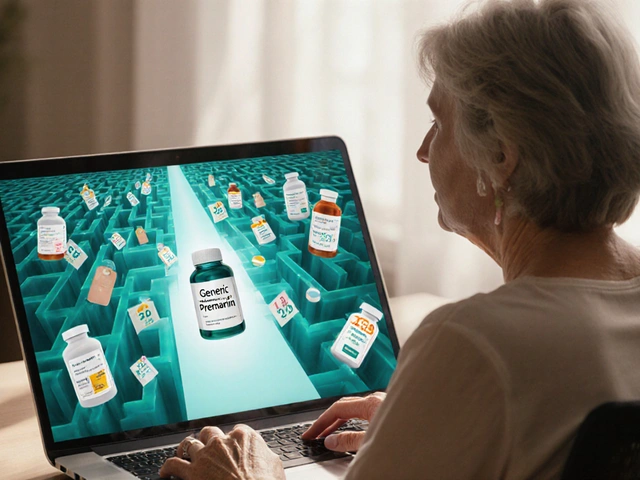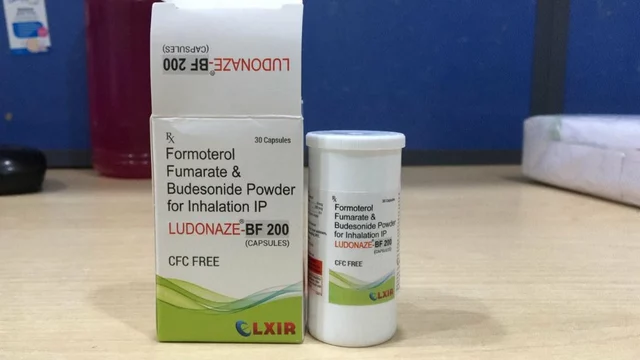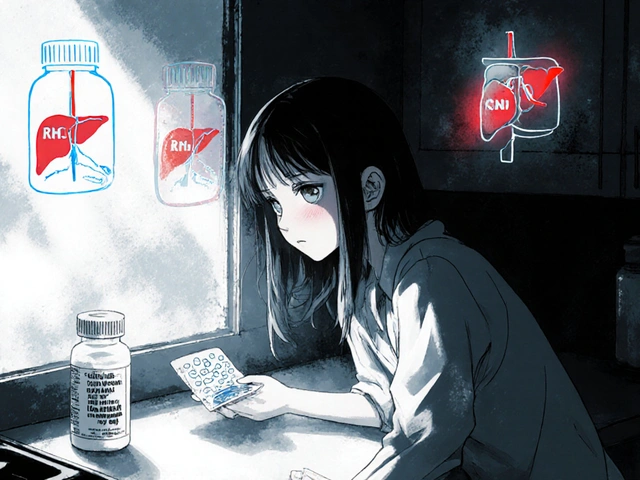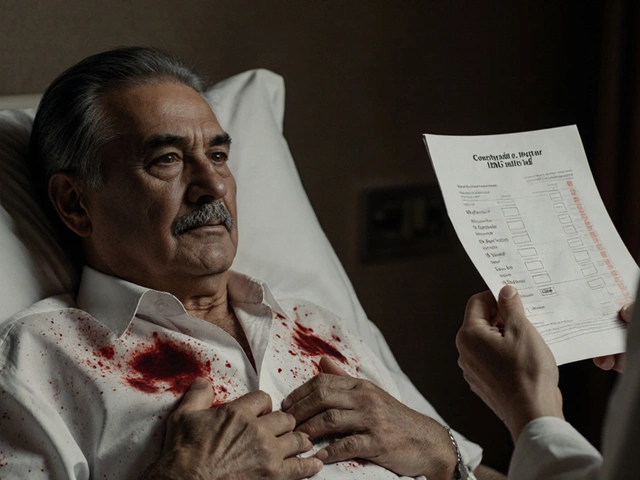When evaluating new targeted therapies, Alpelisib is a selective PI3Kα inhibitor approved for HR‑positive, HER2‑negative breast cancer with a PIK3CA mutation. Researchers and oncologists have been dissecting its trial data for the past few years, trying to decide where it truly fits into everyday practice. This article walks through the most important studies, breaks down the numbers you’ll see on the FDA label, and points out the practical take‑aways for clinicians and patients alike.
Key Takeaways
- Alpelisib showed a 40% improvement in progression‑free survival (PFS) in the pivotal SOLAR‑1 trial for patients with PIK3CA‑mutated disease.
- Overall survival (OS) benefit is modest but becomes clearer after longer follow‑up (median OS gain of 5.5 months).
- Hyperglycemia and rash are the most common grade 3‑4 adverse events; proactive monitoring reduces discontinuations.
- Combining alpelisib with fulvestrant remains the standard first‑line regimen for eligible patients; alternatives like everolimus target the same pathway but have different toxicity profiles.
- Real‑world data from 2023‑2024 confirms trial results while highlighting the importance of managing metabolic side effects.
What Is Alpelisib?
Alpelisib (brand name Piqray) is an oral, small‑molecule inhibitor that blocks the alpha isoform of phosphoinositide‑3‑kinase (PI3Kα). The PI3K pathway drives cell growth and survival; mutations in the PIK3CA gene keep the signal turned on, leading to uncontrolled tumor proliferation.
Because the drug is highly selective for the alpha subunit, it spares the beta and delta isoforms that are important for normal glucose metabolism, although inhibition still raises blood sugar levels in a sizable minority of patients.
Mechanism of Action and Target Population
The drug binds to the catalytic pocket of PI3Kα, preventing phosphorylation of phosphatidylinositol‑4,5‑bisphosphate (PIP2) into PIP3. This blocks downstream AKT activation, halting signals that tell cancer cells to divide.
Regulatory approval limits usage to:
- Adults with HR‑positive, HER2‑negative advanced or metastatic breast cancer.
- Documented activating PIK3CA mutation (detected in tumor tissue or circulating tumor DNA).
- Patients who have progressed on or after an aromatase inhibitor.
This precise definition stems from the trial cohort that demonstrated the biggest benefit.

Overview of Major Clinical Trials
The clinical story of alpelisib revolves around three key studies:
- SOLAR‑1 - a Phase III, double‑blind trial that compared alpelisib + fulvestrant versus placebo + fulvestrant.
- FINER - a Phase II safety‑focused study exploring dosing schedules and early metabolic management.
- REAL‑WORLD Cohort (2023‑2024) - registry data confirming efficacy outside of strict trial inclusion.
The SOLAR‑1 results are the only data set that secured FDA approval, so we’ll dig into those numbers next.
Detailed Results from SOLAR‑1
The trial enrolled 572 patients; 341 had a PIK3CA mutation and received the active drug, while 231 with wild‑type disease received placebo. Primary endpoint was PFS measured by RECIST 1.1.
| Metric | Alpelisib + Fulvestrant | Placebo + Fulvestrant |
|---|---|---|
| Median PFS (months) | 11.0 | 5.7 |
| Hazard Ratio (HR) for progression | 0.65 (95% CI 0.50‑0.85) | - |
| Median OS (months) - final analysis | 39.3 | 33.8 |
| Objective response rate (ORR) | 26% | 9% |
Key points from the data:
- Patients with a confirmed PIK3CA alteration derived the PFS benefit; the wild‑type subgroup showed no statistically significant difference.
- Overall survival advantage grew with longer follow‑up, reaching a median gain of 5.5 months.
- Response rates roughly tripled, indicating that a subset of tumors shrink dramatically under combined endocrine‑targeted therapy.
Safety Profile and Management of Adverse Events
Adverse events (AEs) were common, reflecting the pathway’s role in glucose handling. Grade 3‑4 events occurred in about 38% of patients on alpelisib versus 14% on placebo.
| Adverse Event | Incidence (Alpelisib) | Incidence (Placebo) |
|---|---|---|
| Hyperglycemia | 21% | 3% |
| Rash | 15% | 2% |
| Diarrhea | 7% | 2% |
| Elevated ALT/AST | 5% | 1% |
Practical tips for clinicians:
- Screen fasting glucose and HbA1c before starting therapy; aim for
HbA1c < 6.5%. - Initiate metformin prophylactically in patients with pre‑diabetes; titrate based on weekly glucose checks.
- Use low‑ to medium‑potency topical steroids for rash; consider dose interruption if rash exceeds Grade 2.
- Educate patients about early signs of hyperglycemia (polyuria, thirst) and provide a glucose log sheet.
Approximately 17% of participants discontinued alpelisib due to toxicity, but most interruptions were reversible with supportive care.
How These Results Shape the Current Treatment Landscape
Alpelisib entered a space already occupied by mTOR inhibitors, especially everolimus, which also targets the PI3K/AKT/mTOR axis but at a downstream node.
| Aspect | Alpelisib + Fulvestrant (SOLAR‑1) | Everolimus + Exemestane (BOLERO‑2) |
|---|---|---|
| Population | PIK3CA‑mutated HR⁺/HER2⁻ | HR⁺/HER2⁻, any mutation status |
| Median PFS | 11.0 mo | 6.9 mo |
| Common Grade 3‑4 AEs | Hyperglycemia, rash | Stomatitis, pneumonitis |
| Discontinuation Rate | 17% | 25% |
Key observations:
- When a PIK3CA mutation is present, alpelisib delivers a clearer PFS advantage than everolimus.
- The side‑effect spectra differ, allowing clinicians to personalize therapy based on a patient’s comorbidities (e.g., avoid alpelisib in uncontrolled diabetics).
- Guidelines (NCCN 2024) now list alpelisib + fulvestrant as the preferred option for mutation‑positive disease after aromatase‑inhibitor failure.
Beyond breast cancer, early phase studies are probing alpelisib in PIK3CA‑mutant endometrial and colorectal cancers, but results are still maturing.
Frequently Asked Questions
Who should get alpelisib?
Patients with HR‑positive, HER2‑negative advanced breast cancer who have an activating PIK3CA mutation and have progressed on an aromatase inhibitor are the approved group. Testing can be done on a tissue biopsy or circulating tumor DNA.
How long is alpelisib taken?
The drug is given daily until disease progression or unacceptable toxicity. Dose reductions (from 300 mg to 250 mg or 200 mg) are allowed based on side‑effects.
What monitoring is required?
Baseline fasting glucose, HbA1c, liver enzymes, and a dermatologic exam are recommended. Glucose should be checked weekly for the first 8 weeks, then every 2‑4 weeks. Any grade 2 rash warrants a dose hold and topical therapy.
Can alpelisib be combined with other agents?
The FDA label only approves alpelisib with fulvestrant. Ongoing trials explore combinations with CDK4/6 inhibitors (e.g., ribociclib) and with immunotherapy, but these are not yet standard of care.
What are the costs and insurance coverage?
In the United States, the average wholesale price is around $13,000 per month. Most private insurers cover it for the FDA‑approved indication, often with prior‑authorization requiring documented PIK3CA mutation.
Bottom Line
Alpelisib’s clinical trial data, especially from SOLAR‑1, prove that targeting the PI3Kα isoform can meaningfully delay tumor progression in a genetically defined subset of breast cancer patients. The trade‑off is a predictable metabolic and dermatologic toxicity profile that demands vigilant monitoring. When used correctly, the drug adds a valuable arrow to the oncologist’s quiver, offering an alternative to mTOR inhibitors and a pathway‑specific option that aligns with modern precision‑medicine principles.






Veronica Appleton
24 October 2025 - 22:10 PM
Great overview of alpelisib. I always start patients with a fasting glucose and HbA1c before the first dose. If the HbA1c is above 6.5% I hold treatment and start metformin. Weekly glucose checks for the first two months catch most spikes. Patient education on symptoms of high blood sugar really cuts down on discontinuations.
the sagar
24 October 2025 - 22:16 PM
Don't be fooled the pharma push alpelisib to profit while hiding the real diabetes crisis.
Grace Silver
24 October 2025 - 22:43 PM
The data from SOLAR‑1 invites us to reflect on the evolving narrative of precision oncology. When a mutation tells a tumor where to grow we finally have a key to lock that door. Alpelisib acts as a molecular guardrail that forces cancer cells to confront a metabolic barrier. The modest overall survival gain reminds us that extending life is rarely a sprint. It is a marathon of incremental steps guided by biology. The hyper‑glycemia seen in many patients is a reminder that we are meddling with the body's core energy system. Thus the clinician must become part chemist and part endocrinologist. Monitoring glucose becomes as essential as measuring tumor size. Patients who understand their role in this partnership are more likely to stay on therapy. Education about polyuria and thirst transforms a side effect into a signal. The rash, while unsightly, offers a visual cue that the drug is active. From a philosophical angle the trade‑off between efficacy and toxicity is a classic utilitarian calculation. We weigh months of progression‑free survival against the burden of daily blood‑sugar checks. In the end the decision rests on personal values and the context of each life. So alpelisib represents not just a drug but a dialogue between science, the patient, and the physician.
Clinton Papenfus
24 October 2025 - 22:53 PM
Your exposition on the ethical dimensions of alpelisib is commendable. The clinical implications you outline align with current NCCN guidelines. A disciplined approach to glucose monitoring and rash management will ensure optimal outcomes. I concur that patient‑centered decision making remains paramount.
Zaria Williams
24 October 2025 - 23:33 PM
Yo alpelisib looks lit but the sugar spikes can be a pain for folks with prediabete lol. You gotta keep an eye on that glucose like its a drama series. Also the rash can be ugly so keep those creams handy. If you’re not into daily finger pricks maybe stick with everolimus. But hey the PFS boost is real so it’s worth the hustle.
ram kumar
24 October 2025 - 23:43 PM
Another pharma marvel promising miracles while we foot the bill. The so‑called survival benefit feels like a footnote in a press release. Side effects are painted as manageable yet they dominate the patient’s daily routine. One wonders if we’re trading one nightmare for another. The market will celebrate while the real world bears the scars.
Melanie Vargas
25 October 2025 - 00:06 AM
Remember folks 🌟 monitoring glucose early can keep you on therapy longer 😃. A friendly reminder to log your blood sugar daily 📊. Stay positive and lean on your care team 💪
Deborah Galloway
25 October 2025 - 00:15 AM
I hear you the extra monitoring can feel overwhelming but many patients find the routine becomes second nature. A supportive community can share tips for managing the rash and sugar spikes. Keep the conversation open with your oncologist and you’ll navigate the side effects together.